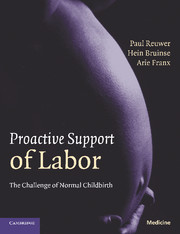Book contents
- Frontmatter
- Contents
- Foreword
- Acknowledgments
- Web-Forum
- 1 General introduction
- Section 1 A wake-up call
- Section 2 Back to basics
- 7 Lessons from nature
- 8 Elementary biophysics of birth
- 9 First-stage labor revisited
- 10 Second-stage labor redefined
- 11 Definitions and verbal precision
- Section 3 Proactive support of labor
- Index
- References
9 - First-stage labor revisited
Published online by Cambridge University Press: 08 September 2009
- Frontmatter
- Contents
- Foreword
- Acknowledgments
- Web-Forum
- 1 General introduction
- Section 1 A wake-up call
- Section 2 Back to basics
- 7 Lessons from nature
- 8 Elementary biophysics of birth
- 9 First-stage labor revisited
- 10 Second-stage labor redefined
- 11 Definitions and verbal precision
- Section 3 Proactive support of labor
- Index
- References
Summary
To allow the passage of the fetus, the cervix must vanish completely, accomplished by effacement and dilatation. These clinical phenomena are consecutive manifestations of one and the same process: the incorporation of the cervix into the lower segment of the uterus. In effective labor, the previously softened cervix first effaces completely (full effacement), followed by progressive dilatation until it has disappeared completely (full dilatation). From this point the uterus, its lower segment, and the vagina form a single open tube through which the baby can be born.
Normal pattern of dilatation
Current teaching and theoretical understanding of normal dilatation rates is still dominated by the work of Friedman, who deserves credit for being the pioneer in this field of research more than 50 years ago, but whose conclusions were actually incorrect. Friedman arbitrarily divided first-stage labor into three artificial sections – from 0 to 3 cm, from 3 to 8 cm, and from 8 cm to full dilatation – and subsequently analyzed these sections statistically, a novelty in those days. As a result he described a characteristic pattern for labor when cervical dilatation is graphed against time: “[The average dilatation curve] takes on the shape of a sigmoid curve: a relatively flat latent phase, followed by the acceleration phase, a steep phase of maximum slope, and ending in a deceleration phase.”
- Type
- Chapter
- Information
- Proactive Support of LaborThe Challenge of Normal Childbirth, pp. 70 - 78Publisher: Cambridge University PressPrint publication year: 2009



